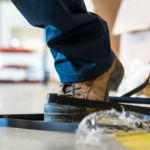National Ladder Safety Month 2023
Every March, the American Ladder Institute (ALI) presents National Ladder Safety Month to promote safe ladder use in the workplace and at home. Every year over one hundred people die in ladder-related accidents, and thousands suffer disabling injuries. Please join the American Ladder Institute by participating in National Ladder Safety Month in March. This important month was designed to raise awareness of ladder safety and to decrease the number of ladder-related injuries and fatalities. For 2023 the focus will be on four key themes:
- Week One: Choosing Your Ladder
- Week Two: Safety Before the First Step (Inspection and Set Up)
- Week Three: Safety While Climbing
- Week Four: Safety at the Top
How to use a ladder safely
Some helpful tips to coincide with the four key themes for National Ladder Safety Month from OSHA include the following:
- Read and follow all labels/markings on the ladder.
- Avoid electrical hazards! – Look for overhead power lines before handling a ladder. Avoid using a metal ladder near power lines or exposed energized electrical equipment.
- Always inspect the ladder prior to using it. If the ladder is damaged, it must be removed from service and tagged until repaired or discarded.
- Always maintain a 3-point (two hands and a foot, or two feet and a hand) contact on the ladder when climbing. Keep your body near the middle of the step and always face the ladder while climbing.
- Only use ladders and appropriate accessories (ladder levelers, jacks or hooks) for their designed purposes.
- Do not use the top step/rung of a ladder as a step/rung unless it was designed for that purpose.
- Use a ladder only on a stable and level surface unless it has been secured (top or bottom) to prevent displacement.
- An extension or straight ladder used to access an elevated surface must extend at least three feet above the point of support. Do not stand on the three top rungs of a straight, single or extension ladder.
- The proper angle for setting up a ladder is to place its base a quarter of the working length of the ladder from the wall or other vertical surface.
- A ladder placed in any location where it can be displaced by other work activities must be secured to prevent displacement or a barricade must be erected to keep traffic away from the ladder.
- Be sure that all locks on an extension ladder are properly engaged.
- Do not exceed the maximum load rating of a ladder. Be aware of the ladder’s load rating and of the weight it is supporting, including the weight of any tools or equipment.
Please contact your Preferred Loss Control Consultant during National Ladder Safety Month and find out how the Vector Solutions online training platform and Streamery, the video streaming service, can be used to provide ladder safety training and education.







